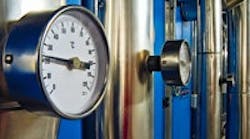Nearly one third of commercial energy used in plants goes to process heating. More efficient use of process heat can result in substantial fuel savings and cost reductions. Completing a detailed analysis of heating needs can help identify the following four critical items to guide optimization:
1. Useful heat needed for processing steps or process stages or by the product;
2. Heat losses associated with the processes that are unavoidable and unrecoverable;
3. Heat losses that can be controlled, reduced or avoided; and
4. Heat losses that can be recovered economically.
[pullquote]
Industrial process heating is classified in three categories — high-, medium- and low-temperature systems. Processes such as cracking of hydrocarbons and synthesis of ammonia require high-temperature heating, while fractionation of oils and most reaction vessels use medium-temperature heating. All drying, evaporation and sterilization processes require low-temperature heating. Cost reduction and optimization opportunities exist in all three categories.
Process heating is carried out either through direct-fired heaters or through heating mediums like steam and thermal oil. For both methods, fuel is burnt in a furnace or boiler. Hence, efficient combustion is the first step to reducing costs. Operator awareness and the use of certain instrumentation at the furnace or boiler can help ensure efficient fuel combustion. Measuring stack gas oxygen and temperature is essential to improve combustion efficiency. If the furnace or boiler is small, use a portable flue gas analyzer to help track heat losses.
For instance, at a graphite electrode manufacturing plant using petroleum coke as the raw material, a carbon anode baking furnace reduced fuel oil usage by 10% when its stack gas conditions were continuously monitored and the air/fuel ratio adjusted. Because the baking process involved releasing hydrocarbon volatiles, recycling the fluegas alone with combustion air supply was enough to cut fuel supply by ensuring complete combustion.
Measuring fluegas oxygen and temperature might suffice to ensure efficient combustion, but when the stack temperature is higher than 280°F it’s worth looking for additional heat recovery. The most-common heat recovery retrofits to furnaces and boilers are economizers, air-preheaters and additional convection coils. In some plants, additional hot water generation or process stream preheating options may be more attractive than the above retrofits.
High-temperature process heaters usually come with good instrumentation and waste heat recovery features. However, if instruments aren’t working properly or not calibrated periodically, the operator is forced to run the heater far from optimal combustion conditions. Also, maintaining the fireside heat transfer surfaces is essential to sustain energy efficiency, especially when liquid and solid fuels are fired. In a petroleum refinery where vacuum processing units fired heavy residue and fuel oil, we added soot blowers to its air preheaters. The soot blowers ensured at least 1% average improvement in the heaters’ combustion efficiency and avoided air preheater bypass operation for the last three to four months of operation (end-of-run condition) prior to the processing unit’s routine turnaround.
Because most chemical plants take raw materials and deliver their final products at ambient temperature, inefficient process heating can lead to excess cooling. Analyzing all the process streams routed through trim-coolers and air-fin coolers could identify the heat recovery potential. If suitable incoming streams (heat sink) heated either by steam or process heaters could recover some of the heat rejected by the cooling streams, both fuel and cooling tower use would decrease, saving energy and pumping costs. Where suitable heat sinks are not available, installing vapor absorption chillers or generating power using organic Rankine cycle could allow you to take advantage of the low-temperature waste heat sources.
Many pharmaceutical and organic fine chemicals plants require areas of controlled humidity that rely on air handling units with both dehumidification and reheat coils. In such plants, the HVAC systems need considerable heating energy after the dehumidification coils. Installing heat pipes or heat recycling through a glycol system could save heat energy as well as chiller load. A heat pipe is a heat transfer device with heat flux rates over 10 times that of conventional heat exchangers. Generally, heat pipes don’t have any moving parts and only require clean heat transfer surfaces. Where hot air drying is practiced, routing the hot air discharged from air compressor cooler fans to the dryer fan suction could save energy and optimize the process heating load.

VEN V. VENKATESAN is Chemical Processing's Energy Columnist. You can e-mail him at [email protected]
Latest from Energy Efficiency
Latest from Energy Efficiency


